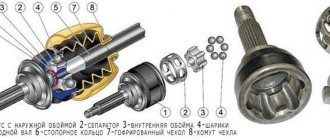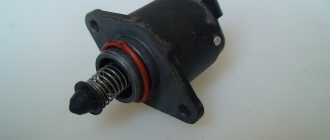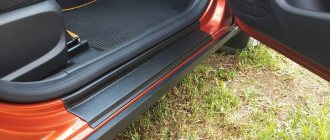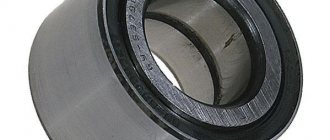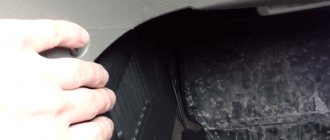August 25, 2016 Lada.Online 12,272 1
On August 24, 2016, at MIAS, AVTOVAZ presented a future crossover called Lada XCODE. After the launch of production of Vesta and XRAY, everyone saw the new bright and unique car design. The new XCODE inherits the X-shaped features of these models. You can view the features of this model from the photo gallery.
Exterior of LADA XCODE
From the photographs presented, you can see that the X-shaped aluminum elements on the front bumper have acquired a more defined shape and now flow into the headlights. Sloping headlights, being a continuation of the radiator grille, make the car visually wider. The side/daytime running light functions have been visually separated from the main headlight units, creating the appearance of individual “eyelashes” that are integrated into the concept's sculpted hood. The rear lights have a visual connection with the X-shaped rear fenders and are an extension of the C-pillar, which is made in the shape of a “shark fin”. The sides of the body are also made in the familiar X-shaped style.
The outer handles of the rear doors were hidden by moving them in a vertical position to the black area of the door frame. The sloping roof surface allows airflow to flow between the roof and the rear spoiler, improving aerodynamic efficiency. At the rear, too, you can see a clear X-shaped graphic created by the tailgate glass with a pronounced trapezoidal shape, framed by two taillights.
Technical characteristics of Lada X Code
Dimensions of LADA XCODE The dimensions of the new domestic crossover are difficult to visually assess, but by eye they are very close to the dimensions of the same Lada X Rey. The length of the model is a little more than 4 meters or so. When creating the serial Lada X Code, the manufacturer promises to use the Kalina platform, the wheelbase of which is 2,476 mm, but for the new product they promise to increase the base slightly. For example, the wheelbase of the same XRay is 2592 mm, but even with these dimensions the car is frankly a bit cramped. So you can’t expect much space from XCODE.
Engine LADA XCODE
The manufacturer announced the use of a turbo engine as the main engine for the model, which will appear in 2022. This is not fantasy, but harsh reality. A 1.4 liter turbo engine with 16 valves was developed by AvtoVAZ several years ago, and with state money. Back in 2012, the government allocated significant funds to the domestic auto giant for the development of a hybrid power unit with a turbo engine. Avtovaz quite quickly absorbed all financial resources, and showed a hybrid Lada Granta as a report. The engine was created on the basis of the VAZ-11194 engine (1,390 cm3 89 hp). A turbine was screwed to the 16-valve power unit, as a result, the power was raised to almost 163 hp, with a torque of 240 Nm! Depending on the turbine performance, the power can be easily varied. Until now, there was simply nowhere to put your development. But then an opportunity arose and now it is known for sure that this development of VAZ engineers will go under the hood of the Lada X Code. In addition, they promise the appearance of an all-wheel drive transmission. Most likely they will simply borrow the all-wheel drive system from the same Renault Duster.
Interior of LADA XCODE
The conceptual interior of the car combines a digital instrument cluster and a 10-inch screen of a multimedia system integrated with LADA Cloud cloud services.
The concept is being developed taking into account the use of the promising LADA Connect system. It will allow you to combine all the car’s systems into a single, coherent system that will be controlled via your phone.
Photos of the Lada X Code interior
Unfortunately, it was not possible to look into the Lada XCode salon. The doors were locked, but we could see something. Firstly, a completely new center console. Instead of a gearshift lever there is a large washer for switching transmission modes. The dashboard also has a rather interesting design. And the central touch monitor is removable; it looks like a regular tablet. By the way, a new telematics platform system LADA Connect , which allows you to control car systems using a smartphone/tablet, and in the future use cloud services from the car.
Other Features
The technical characteristics of the Lada XCODE remain unknown for now, but it is assumed that the crossover will be built on the basis of the Kalina, but its power frame will be hung with different body panels. the front part will come from Vesta (spar design, front suspension and steering mechanism). It is expected that the XCODE will be smaller in size than the Renault Duster, but larger than the Kalinovskaya (approximately 2,500 mm).
The XCODE concept also includes new active driver assistance systems:
- Automatic emergency braking before an obstacle;
- Automatic parallel and perpendicular parking;
- Active cruise control with the function of maintaining the distance to the vehicle in front;
- Remote control of the car.
Review of Lada XCODE on video:
Little is known about the concept crossover yet, but work on it is already underway. The car concept potentially provides for a number of promising solutions, including an all-wheel drive transmission and a turbo engine. According to AVTOVAZ’s plans, the production version of the new crossover will hit the production line by the end of 2022. Let us remind you that the site also contains other photos and video materials about the future Lada crossover.
Photo: xcodeclub VK group
Keywords: lada xcode
1 0 0 0 0 0
Share on social networks:
Serial crossover Lada XCODE – all the details
Recently, AVTOVAZ has accustomed us to the fact that it presents concept cars for a reason. Yes, the first concept car of the new era, shown in 2012 Lada Xray, did not become a production car - the real X-Ray, as we know, looks different - but it clearly set a new corporate style that Lada will follow in the near future . XCODE is the second stage in the evolution of this style. But more importantly, it looks much closer to a production car than the first concept.
Take a closer look, in XCODE there really is not a single deliberately “conceptual” element, which were present in Xray-2012 (just remember its interior), and almost everything, with minor exceptions, looks as if it does not require adaptation to mass production at all. Moreover, the “Concepts” section has appeared on the official AVTOVAZ website, where all six concept cars shown at MIAS 2016 are present, and X-Code is given first place in the list.
According to the tradition that occurs with other manufacturers, cars from the “Concepts” section very often migrate over time to the main model range. In addition to the X-Code, in this section Lada has cars that are sure to become serial - sports and “cross” modifications of Vesta and Xray.
Actually, most of the doubts were dispelled by Nicolas More, who at the end of August 2016 told the press that the Lada XCODE would appear in the series in five years or even a little earlier, and in the lineup it would take a place between the Kalina Cross SUV and the just introduced Xray Cross. The latter, by the way, before the appearance of the X-Code, is entrusted with the task of competing with cars in the fast-growing segment - Hyundai Creta and Renault Kaptur. A little later, in September, this idea was developed by Harold Grübel, voicing a forecast: in the next few years, up to 50% of the market could be occupied by crossovers and SUVs, SUVs and SUVs. So Lada XCODE definitely has a future.
Among the technical solutions announced are all-wheel drive and a turbo engine, . There is still no clarity about the 4x4 system for new Lada cars - either it will be a transmission borrowed from Renault-Nissan, or developed in-house by AVTOVAZ. But both the Xray Cross and the serial version of XCODE will definitely have all-wheel drive.
An interesting situation with the turbo engine: as you know, AVTOVAZ has developments on a 1.4-liter gasoline turbo engine, and moreover, it is also part of an experimental hybrid power plant that was tested on the Lada Granta. It is likely that one of the versions of the serial Lada XCODE will turn out to be a rechargeable hybrid capable of driving on pure electric power.
The most important question at the moment is the platform of the future crossover. AVTOVAZ claims that the project is at the stage of studying consumer interest, the platform has not yet been determined, and because of this, even the exact dimensions of the future car are unknown. But this is hardly entirely true, given the announced timing of the model’s appearance on the assembly line. At a minimum, there are definitely a number of options. Let's try to understand which ones exactly.
The first option is a borrowed version of the new CMF platform from the Renault-Nissan alliance. The concept of this platform (or rather, architecture) divides the entire car into five zones - the power plant, the front of the chassis, the rear, the cockpit (interior) and electrical/electronics. For each such zone there is a certain set of suitable solutions. According to the status of these solutions, the platform is divided into three subtypes - CMF-A, CMF-B and CMF-CD. For the first time, Nicolas More indirectly hinted at the use of CMF when he spoke about a compact car for Russia, like the Indian Kwid - let us remind you that the Kwid is based on CMF-A. More precisely, the president of AVTOVAZ pointed to the new architecture of the Alliance already in the context of a conversation about Lada XCODE, saying that instead of the previous borrowed B0 platform, the Lada brand will gradually switch to CMF-B.
By the way, the second generation Nissan Juke and Renault Duster crossovers, which will hit the market in 2017, are based on this platform. The CMF platform option on the new Lada crossover is possible because it meets the principle of “lean engineering” proclaimed by Carlos Ghosn with the launch of the Renault Kwid and the CMF platform.
The second option is to use AVTOVAZ’s own resources. In September, Gruebel came out with an interesting phrase: “Over the next five years, we will combine the Granta/Kalina and Vesta platforms.” What is behind this is still unclear (according to one version, XCODE will receive the Kalina body frame, but with the front part of the Vesta platform “implanted” into it), but this is fully consistent with the policy of reducing the number of platforms - Lada now has four of them, not counting the borrowed one B0, it is planned to leave two or three. This is, in essence, the same “lean engineering” - not developing a new platform, wasting engineering resources on it, but using combinations and upgrades of what already exists. Which, oddly enough, is very reminiscent of the modular approach used in the CMF architecture.
Is it possible that in reality we will see some kind of combination of these approaches - for example, could individual parts of the Lada B (Vesta) platform be included in the CMF “constructor” set? This would correspond to the principles outlined above, and would also be fully consistent with the course towards the maximum possible localization taken by Nicolas Mohr and already being implemented by Harald Grübel. However, for now such assumptions look too fantastic.
By the way, the name XCODE itself is still quite fantastic and speculative: it is not at all a fact that the car will be called that way in the series. Let us remind you that back in June 2016, AVTOVAZ registered the name “Xray X”, and what is hidden behind it is currently unclear - maybe an all-wheel drive version of the Xray Cross, or perhaps just the production version of XCODE.
But it is known for sure that the new crossover will feature the Lada Connect system, which combines the car’s multimedia system and a smartphone, linking together information, navigation and entertainment services, as well as driver assistance systems: automatic emergency braking, automatic parking, active cruise control and even remote control of the car.
Finally, it should be noted that Harold Gruebel identifies three technologies that the Lada brand will develop in the coming years: new engines, all-wheel drive systems and... automatic transmissions. According to him, the AMT transmission developed and already used on Lada cars will undergo improvements, and in addition, a certain version of the classic “automatic” may appear, localized in the Volga region.
The prerequisites for this already exist: as you know, the Tolyatti FEZ is already producing the Jatco automatic transmission switching mechanism, which is installed on Granta, Kalina and a couple of Datsun models, also assembled on the VAZ assembly line, and in the future the localization of “automatic machines” will become more , and, as it became known to the Kolesa.ru website that we are not only talking about casting plastic components.
So, belonging to the most popular segment in the future, a new (whatever) platform, a successfully developed “X-style”, a hybrid power plant with a gasoline turbo engine and the ability to drive on pure electric power, all-wheel drive, automatic transmission, aggregation of vehicle systems with a smartphone and the latest active driver assistance systems... Sounds good, so we are waiting for you, serial XCODE!

